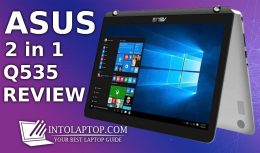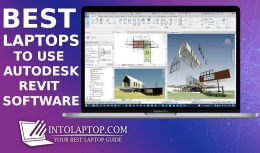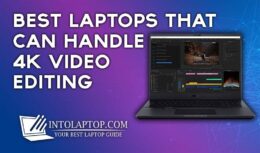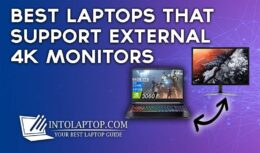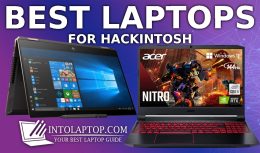 As compared to the previous year’s Apple’s lineup of MacBook laptops is now even more streamlined. The original 13 inches MacBook Air and MacBook 12 inches have vanished.
As compared to the previous year’s Apple’s lineup of MacBook laptops is now even more streamlined. The original 13 inches MacBook Air and MacBook 12 inches have vanished.
Just a new 13 inches MacBook Air, the 13 inches MacBook Pro which has two versions, and a powerful 16 inches MacBook Pro are available now. So if you are confused that for which device you should go then you are at the right place.
We have checked and analyzed all of the Mac computers on the market, and we have selected the best ones for you by hand. So if you’re looking to make the Windows switch or want to update your old one, you should read this article before making the final decision. Into Laptop’s Laptop Buying Guide is here to help you with the basics and advanced technical features of today’s modern laptops and Macbooks.
Also Check Out: Best Laptops by Brands
10 Best Apple MacBook Laptops Review in 2024
| Laptop Model | RAM | Processor | |
|---|---|---|---|
| 1. Apple MacBook Pro 16 inch | 16GB | Intel Core i9-9880H | |
| 2. Apple MacBook Air 13 inch | 8GB | Intel Core i5-8210Y | |
| 3. Apple MacBook Pro 13 inch | 8GB | Intel Core i5-8257U | |
| 4. Apple MacBook Air 13 inch | 8GB | Intel Core i5-5250U | |
| 5. Apple MacBook Pro 13 inch | 8GB | Intel Core i5 | |
| 6. Apple MacBook Pro 15 inch | 16GB | Intel Core i7-8850H | |
| 7. Apple MacBook Pro 15 inch | 16GB | Intel Core i7 | |
| 8. Apple MacBook Pro 13 inch | 8GB | Intel Core i5 | |
| 9. Apple MacBook Air 13 inch | 8GB | Intel Core i5-8210Y | |
| 10. New Apple MacBook Air 13 inch | 8GB | Intel Core i5-8210Y |
By holding their own against the rest of them certainly, the best Macs and MacBooks occupy their place in the computer world. not only with their strong components but their subtle and incredibly tough designs too.
That is why the computing needs of many creative professionals depend on them.
Below we have not only listed the top 10 best Apple MacBook laptops that you can get in the year 2023 but we have also included their detailed review as well for your convenience.
Also, you can check out even more laptops under a specific budget on intolaptop.com.
So without any further delay, let’s jump into the article to find you the best MacBook for your needs.
1. Apple MacBook Pro 16 inches
“Larger Display & Bigger Battery”
- Display: 16″, FHD, 3072 x 1920, Retina Display
- Processor: Intel Core i9-9880H, 2.3GHz, 8 Core
- Graphics Card: Amd Radeon Pro 5500M, GDDR6
- RAM & Storage: 16GB DDR4, 1TB SSD
- Operating System: macOS
- Keyboard is Great
- Slimmer Bezels
- Amazing Speakers
- Powerful Processor
- Display is Not 4K
- Slightly Heavier
Design
The MacBook Pro’s basic design has not changed despite the fact that the bigger screen and higher capacity battery has allowed the use of a thicker casing. In our view, the MacBook Pro 16 looks so similar to its predecessor in the overall design that when they are side by side it will be hard to tell the two apart.
In its laptops, Apple still needs to follow the high screen to body ratios however as compared to the MacBook Pro 15, the MacBook Pro 16 has significantly smaller display bezels than.
Silver and Space Gray are the tow color schemes in which Apple has continued to sell the biggest MacBook Pro. The most important thing is that with MacBook Pro, Apple has again maintained the excellent craftsmanship and build quality which users expect from it.
Its finish does not bear fingerprints as easily as some of its competitor’s plastic surfaces do since the aluminum case makes the MacBook Pro 16 feel luxurious. Ultimately, our analysis device is robust, and with our best efforts, we could not twist the frame.
As is its panel hinge the shell is similarly rigid as well. The screen does not wobble while typing and it can be open with a single hand. The hinge allows the screen to be opened up to around 135 ° too, the very same position that can be opened to the most recent MacBook Pro 15.
On the most recent MacBook, Pro 16 Apple is also using patented Pentalobe screws. Those attach the bottom case to the frame but with the right screwdriver, they can be removed easily.
Display
The display is one of the most noticeable improvements in the latest MacBook Pro. Instead of OLED the new 16 inches screen is IPS, and still carries the Retina branding of the product.
However, the 3072×1920 panel’s 226 PPI pixel density is lower than that of comparable 4 K displays, including the ones in Lenovo ThinkPad X1 Extreme Gen 2 and Dell XPS 15 7590.
With its MacBook Pro range, Apple continues to sell only one single screen version which is neither capable of HDR nor high refresh rates. The MacBook Pro 16 as having a 16 inches display of 500 cd / m2 according to Apple, a statement that is only valid in the X-Rite i1Pro 2 display center of our review unit.
The program reports the panel as being uniformly lit at 86 percent, resulting in an average maximum luminosity of 477 cd / m2. The screen also has an appropriate black value which we were measuring at 0.39 cd / m2.
All of our comparison laptops reach significantly lower black values other than the Dell XPS 15 7590, but in this regard, there are plenty of other laptops better than the MacBook Pro 16.
That also refers to the contrast ratio of 1,331:1 for our review unit. This frequency is so high, however, and it changes so marginally as the brightness levels change, that it will definitely be going to affect your eyes especially if you work on this laptop for two long.
Performance Under Workload
No matter which edition you buy the MacBook Pro 16 is a versatile multimedia laptop. Along with an option of three AMD Radeon Pro GPUs Apple provides the system with Hexa or octa-core Coffee Lake processors.
Technically speaking, it’s only two but the Radeon Pro 5500 M comes in versions of 4 GB and 8 GB. You can also upgrade the MacBook Pro 16 with DDR4-2666 RAM up to 64 GB, and an 8 TB SSD.
Although we ran most of our benchmarks on macOS, we ran them on Windows 10 even using Boot Camp for comparability purposes. Apple has designed most drivers well for Windows 10 Boot Camp, making it in most respects a good alternative to the macOS.
Nonetheless, you have to stick with the GPU being permanently activated, which can affect battery life, although some test results are for some reason lower than what they are in macOS.
Our review unit is operated by the Core i9-9880H, an octa-core processor that in the most recent MacBook Pro 15 we have already benchmarked. Intel bases the chip on its architecture in Coffee Lake, which was first launched in Q3 2017 and it was manufactured on a 14 nm process.
Although the MacBook Pro 16 tops all of our PCMark benchmark tables, then at first glance its predominance is even more impressive. In simple words, this laptop is meant for hardcore work requirements.
BUY NOW ON AMAZON2. Apple MacBook Air 13 inches
“Thin & Lightweight with Sharp Retina Display”
- Display: 13.3″, FHD, 2560 x 1600, Retina Display
- Processor: Intel Core i5-8210Y, Dual-Core, 8th Gen
- Graphics Card: Intel UHD Graphics 617
- RAM & Storage: 8GB DDR4, 256GB SSD
- Operating System: macOS
- Slim & Portable Design
- Aluminium Chassis
- Thunderbolt 3.0 Ports
- Touch ID, Touch Bar
- Comparatively Slower Performance
- Display Should Be Brighter
Design
The updated Apple MacBook Air concept is almost identical to the existing MacBook Pro range and the only difference is the tapered top. Apple mentions that for the first time the frame is made of 100 percent recycled aluminum.
This could be the reason that the feeling of design is just as strong as on the more expensive models. for such a slim laptop, the stability is excellent and the build quality is impeccable.
It just feels like you’re using a high-quality product because of the metal surface’s haptic impression. After a few years of use, the surfaces still look fantastic and the new MacBook Air will not be an exception.
We can confirm it based on our own experience with Apple products. The new Air is also available in gold in addition to the two popular silver and space gray color options, previously which was only reserved for the smaller MacBook 12 inches.
Compared to the previous generation, Apple has reduced the bezels, but when we compare it with XPS 13 it seems like there is still scope for optimization.
The central hinge is well balanced and can prevent the screen from bouncing. Because of the light base unit, it isn’t easy to open the lid with one hand. 135–140 degrees is the average angle of opening.
Multiple Pentalobe-screws protect the bottom plate. When you have the correct device, it is easy to remove, but so there’s not much to do since almost all the parts are either glued into the frame or soldered.
Display
The screen was probably the old MacBook Air’s greatest downside, as the 13.3 inches screen was still based on TN technology with small viewing angles and a low resolution of 1440 x 900 pixels.
It was far from the expectations of Apple itself Retina technology, which would improve with the updated edition. Thankfully now you can get a 13.3 inches screen with 2560 x 1600 pixels (16:10, 227 PPI), identical to the new MacBook Pro 13.
But a closer look at the specs indicates variations in price. Apple is advertising the MacBook Pro 13 for the latest MacBook Air with a 500 nit screen and full P3 coverage but it actually provides just 48 percent more colors than the old version.
During our analysis of the last MacBook Air, we calculated about 60 percent sRGB, so the new Air will hit the full sRGB gamut hopefully. Apple does not state the luminosity at all, however.
As compared to the last generation MacBook Air’s old TN panel subjectively, you’ll instantly note the difference. The text is extremely bright, but the colors are not as vibrant as on MacBook Pro devices obviously very fine screens.
Nor can the luminance keep up with the Pro models. For the panel with the designation APPA039, we evaluate an average value of 315 nits. Just the two Asus and HP 1080p rivals are marginally darker while all the other high-resolution screen comparison models are much brighter than this laptop.
Performance Under Workload
For the new MacBook Air, the performance is an interesting topic because for many customers the designation of the processor suggests a higher performance level.
Like Apple introduces only a dual-core processor while almost all other Core i5 8th Gen CPU’s offers four native CPU cores. The subjective performance impression with daily tasks is still very strong, thanks to quick PCIe-storage.
With the less-powerful configuration, most users who don’t know whether they need a dual-core or a quad-core should be well. The memory is soldered onto the motherboard (either 8 or 16 GB LPDDR3-2133) and it is not possible to upgrade it any further.
The current nomenclature of Intel will make measuring the performance of the level processor very difficult. Apple uses an 8th generation Core processor with the Core i5-8210Y label.
The Y at the end means a highly powerful processor, which can normally be passively cooled. The design is named Amber Lake-Y, which was used in the tiny MacBook 12 and it based on Kaby Lake-Y.
However, the main difference to the MacBook 12 is the add-on fan. This is uncommon for this type of processor and should boost efficiency during prolonged workloads in particular.
We’re going to take another look at the cooling solution, but it looks like there’s no Heat pipe because the fan isn’t attached directly to the pipe.
BUY NOW ON AMAZON3. Apple MacBook Pro 13 inch
“Best Combo of Display Quality, Speed & Battery Life”
- Display: 13.3″, FHD, 2560 x 1600, Retina Display, True Tone
- Processor: Intel Core i5-8257U, Quad-Core, 2.4GHz, 8th Gen
- Graphics Card: Intel Iris Plus Graphics 655
- RAM & Storage: 8GB LPDDR3, 256GB SSD
- Operating System: macOS
- Battery Life is Great
- Performance is Fast
- Color Full Bright Display
- Powerful Speakers
- Bezels are Thick
- Only Two Thunder Bolt 3 Ports
- Keyboard has Shallow Key Travel
Design
The style hasn’t changed except for the TouchPad. The only noticeable difference is the number of ports from now on between the two 13 inches Pro versions.
However, as compared to last year’s model there are minor improvements inside like the battery has slightly higher strength, the CPU heat pipe and the speakers, on the other hand, are a little smaller. The reliability of the case is still outstanding and comparable to the costlier MacBook Pro 13.
Removal of the bottom panel is pretty simple but only if you have the right Pentalobe screwdriver, but it is not much you can upgrade, although you can clean the fan easily.
All the remaining components are either soldered on the logic board or glued into the case. All comes fitted with the OLED Touch Bar above the keyboard it doesn’t matter which model you get from the current MacBook Pro.
The bar shows different details according to the query. Compared to previous years, when the program and the Touch Bar optimization also rely on it. For daily circumstances such as flipping between various Safari windows, it can be a helpful gadget but often it only doubles the content.
Similar to the old model of dedicated function keys, it often needs one more input to adjust items like brightness or volume. However, this OLED Touch bar is a cool feature to have in your Apple MacBook Pro 13 inches laptop.
Display
When you purchase a MacBook Pro 13, you don’t have to worry about the display. The 13.3 inches IPS screen provides outstanding subjective image quality without distracting flickering from the backlight and it has a resolution of 2560 x 1600 pixels. The contents are very sharp and look very vivid.
The brightness adjusts very well to the ambient light and true tone is also enabled, too. The average luminance at 577 nits is very good, and even exceeds our MacBook Pro 13 test unit with four TB3 ports.
Given the high luminance, the black value 0.35 is still good and results in an outstanding contrast ratio of more than 1700:1. At a very high 116 kHz, we can only measure a flickering of the background light since the PWM is not used to manage the brightness.
It can not, however, be associated with conventional PWM. The calibration of the screen is already really strong off the rack. Our measurements with the skilled CalMAN program and the spectrophotometer X-Rite i1 Pro 2 confirm that the color deviations are below the relevant 3 limits and we didn’t encounter any noticeable color cast on this display.
Calibrating the display is not really important but we still tried it and managed to further boost the performance. In fact, this display is one of the best improvements Apple has done in any of its MacBook laptops so far.
Performance Under Workload
The Apple MacBook Pro 13’s subjective output impression is very strong, but considering the fast processor and the SSD, this is hardly shocking. Inputs are performed without delays, and the fast launch of applications can be considered normal for this powerful laptop.
For the next few years, there’s also performance headroom, particularly as compared to the slightly cheaper MacBook Air. Executing the occasional Windows program is also no problem.
Bootcamp performed very well in our tests and even the Touch Bar with special functions such as brightness and volume control works as expected. Apple uses chips with more powerful integrated GPUs, unlike standard ULV processors.
In this case, the Iris Plus Graphics 655, which is faster then the Iris Plus Graphics 645, is fitted with an eDRAM cache of 128 MB. While the regular UHD Graphics 620 is beaten by 30-40% the gap in the more expensive MBP 13 between the 645 and the 655 is not that high.
Although gaming isn’t its strong suit the Iris Plus Graphics 655 is very well suited for standard multimedia applications and high-resolution video playback. Simpler games, like DOTA 2 for example, can only be treated at medium detail.
The fan noise with function keys is identical to the old MacBook Pro 13 since the single fan does quite a good job. The fan can reach 39 dB under load and it increases the velocity gradually.
BUY NOW ON AMAZON4. Apple MacBook Air 13 inches
“Ultraportable Design With Excellent Battery Life”
- Light Weight & Thin
- Long Battery Life
- Portable
- Multiple USB Ports
- Older Processor
- Resolution is Low
Design
The oldest piece of Apple’s hardware has been quietly upgraded without much ado. So with that, all hope is gone for a showing of higher resolution. This seems more like instead of replacing it from the ground up Apple is making final plans for the retirement of MacBook Air.
Most likely this is because of their recent plan for the product. The Air is Apple’s most accessible road to the cosmos still. The MacBook Air is a true steal with its 13.3-display offering the resolution of 1440 x 900, 1.8 GHz dual-core processor, 8 GB of RAM, and a colossal 128 GB SSD at the Price tag of only $999.
Unfortunately, it does not include an IPS panel with decent viewing angles at this cost, and Apple’s Force Touch touchpad is also missing. It is therefore fair for Apple to refrain from making a public announcement on what can only be described as continuing life support for its Air lineup.
However, to keep the Air around for another year, thus continuing to market it at a high profit to satisfy the still incredibly strong demand. In our test we selected the simple entry-level model, It has been improved to 1.8 GHz only recently and is fitted with a faster 128 GB SSD as well.
But is otherwise similar to its predecessor. The case is as same as the Apple MacBook 13 2015 version. Our scale comparison clearly shows we’ve seen huge changes over the last seven years in terms of profile.
As compared to the MacBook Air 13 even the much heavier MacBook Pro 13 is now smaller and slimmer but its weight is almost similar.
Display
With a highly reflective coating Apple obviously still has its Air laptop fitted with the well known 13.3 inches TN panel. At this scale, its resolution of only 1440 x 900 translates into a pixel density of 128 PPI.
This is not only relatively small compared to the 1920 x 1080 FHD panels which have become more common in the last few years but it is also fairly low in comparison with Apple’s own Retina displays, like its 13 inches MacBook Pro with 227 PPI.
The comparison with the MacBook 12, with its 2304 x 1440 resolution and 226 PPI display of 12 inches, makes it painfully apparent how crisp and transparent a screen can be in 2021 and how old and horrible the Air display is.
When reading text, where the lack of sharpness of the Air results in blurred shading around the edges, this issue becomes even more apparent. Upon the first introduction of MacBook Air, TN panels were still very popular.
Unfortunately, the new version still features the very same TN screen, meaning, on the one hand, lower response times but on the other hand substantially reduced viewing angles.
Grey to gray took just 52.4 milliseconds and the black to white response time was found to be 28.4 milliseconds with our new sensors. So, the screen of the Air doesn’t really stand out as opposed to the much more modern IPS screen of the MacBook 12.
Performance Under Workload
However, the new Air 13 has really improved one thing over the previous one and we will talk about that first. The previous generation i5-5250U 1.6 GHz has been replaced by an i5-5350U 1.8 GHz since Apple has continued to suit its Air with Intel’s Broadwell CPUs since the company is still using bottom shelf CPU’s.
This translates into a 200 MHz or 12.5 percent big bump results. The trusty Intel HD Graphics 6000 remains the flavor of the month for Apple as far as the graphics card is concerned.
We were shocked to see the latest i5-equipped MacBook Air 2017 perform almost exactly as well as the two-year-old Core i7 model while observing the benchmarks more closely.
It scored 116 points in the single-core Cinebench check whereas the two years old Core i7 score was 112 points for 2015. We believe the difference in output between the two versions is negligible at this point because of the fact that Apple still sells the 2.2 GHz Core i7 processor for an additional $150.
Having said that, one of the critical aspects of perceived efficiency is not only how well a device performs under short bursts of the load. Whether or not it is able to sustain that high-performance level over extended periods of time, for example when making a video is a more important concern.
The performance of the newer i5 equipped 2017 model was once again very similar to the older, i7-equipped 2015 MacBook Air in PCMark 8. In this comparison, the MacBook 12 fell behind and the much more costly MacBook Pro performed better which is not surprising at all.
BUY NOW ON AMAZON5. Apple MacBook Pro 13 inches
“Faster Performance & Excellent Keyboard”
- Display: 13″, 2560 x 1600, Retina Display
- Processor: Intel Core i5, 2.4GHz, Quad-Core, 8th Gen
- Graphics Card: Intel Iris Plus Graphics 655
- RAM & Storage: 8GB, 512GB SSD
- Operating System: macOS
- Improved Keyboard
- Fast Performance
- Colorful retina Display
- Great Speakers
- Thick Bezels
- Slightly Heavier
- Battery Life is Short
Design
In Space Gray or Silver, the 13-inch MacBook Pro with Touch Bar is a powerful and stylish piece of aluminum. But at this point, the look is getting outdated, compared to the likes of the Dell XPS 13 and other Windows notebooks and 2-in-1 laptops the bezels around the screen looks very thick.
This MacBook Pro is very compact, at a weight of 3.02 pounds and 0.59 inches thickness, yet again other Windows laptops are much sleeker. For example, the XPS 13 weighs 2.7 pounds and is between 0.3 and 0.5 inches thick.
The HP Spectre x360 is also marginally lighter at2.9 pounds and slimmer at 0.5 inches than the MacBook Pro, including a touch-screen. One of the advantages of splurging for the 13 inches MacBook Pro Touch Bar model is that you are getting four Thunderbolt 3 ports two on the right and two on the left side.
The MacBook Pro non-Touch Bar only has two Thunderbolt 3 ports on the left side. For this Touch Bar MacBook Pro, the headphone jack is on the right side. The main thing which is missing is the memory card slot.
Since the microSD card reader comes included in the Dell XPS 13, the 13 inches model HP Spectre x360 and the Lenovo Yoga C930. Plus, a full-size USB 3.1 port is available in the HP and Lenovo.
The bad news is that the current iteration of the butterfly keyboard on Apple’s 13 inches MacBook Pro has the same shallow travel as previous models.
Display
the elegance of this 13 inches MacBook Pro screen is hard to disagree with however we would certainly like to see Apple jump to 4 K. The Retina display of 2560 x 1600 pixels is vivid, colorful and precise.
In our lab tests, the panel itself also beamed, as it reported an average brightness of 408 nits. With that, this MacBook laptop easily beats the 13 inches HP Spectre x360 model 287 nits and the Lenovo Yoga C930 model 273 nits.
The MacBook result even outshines the 375 nits of the XPS 13 model. The screen of the MacBook Pro is not the most colorful in our tests it reproduced 118 percent of the sRGB color gamut, which is better than the result of the Yoga C930 100 percent but behind those of the XPS 13 119 percent and Spectre x360 150 percent.
However, you won’t find a show with more accurate hues. The panel of the 13 inches MacBook Pro turned into a 0.12 Delta-E ranking. A zero score is just fine. We hope that in future with slimmer bezels Apple introduces a sleeker design and that more battery life could be squeezed out of this model.
But overall for power users on the go the 13 inches, Touch Bar MacBook Pro is a blazing-fast laptop. As far as display is concerned as we know that while buying a laptop you have to compromise on a few things however if you want to get a better display panel then you should choose another version but it will cost you more.
Performance Under Workload
The 13 inches MacBook Pro with Touch Bar can easily be considered one of the best laptops ever. Our setup bundles an 8th-gen quad-core Intel Core i5 processor operating at 2.4-GHz, 8 GB RAM and 512 GB SSD.
And when we switched between 17 tabs in Chrome while running Skype, Slack and Pixelmator we didn’t see any latency. The 13 inches MacBook scored a very good 18.221 on Geekbench 4.1, which tests overall performance.
Which wipes the floor with the 14.936 marks of the Dell XPS 13 Core i7-8565U, 16 GB RAM and the 14.935 scores of the HP Spectre x360 13-inch model Core i7-8565U, 8 GB RAM.
The MacBook Pro was a full 5 minutes faster than its nearest rival, the XPS 13, which required 19:20 to complete the same tasks in our video editing check. In which we transcode a 4 K video file to 1080p.
The HP Spectre x360 13 and the Yoga C930 both took more than 20 minutes. SSD of the MacBook Pro is still strong to easily perform any work-related task. This system turned in a write speed of 2.573 MBps on the Blackmagic Disk Speed Test.
On the same scale, the Dell XPS 13 just hit 226.4 MBps while the HP Spectre x360 13 hit 616.3 MBps. Nonetheless, you should not expect this MacBook Pro to offer the greatest graphics performance.
It turned on the Dirt 3 racing game at low settings in a frame rate of 38 fps, while the XPS 13 hit 88 fps, and the Spectre x350 reached 56 fps.
BUY NOW ON AMAZON6. Apple MacBook Pro 15 inches
“Well Build Design & Hardcore Specs”
- Display: 15″, 2880 x 1800, 4K, True Tone
- Processor: Intel Core i7-8850H, 2.6GHz, Hexa-Core, 8th Gen
- Graphics Card: Radeon Pro 555x or 560x, 4GB
- RAM & Storage: 16GB, 256GB SSD
- Operating System: macOS
- Powerful Performance
- Amazing Screen
- 4K Display
- Decent Options for Configurations
- Less Ports
- Expensive
Design
Compared to its predecessor, the layout of the latest MacBook Pro 15 has not changed. It appears to have been somewhat reworked by the maker, as the battery is a little bigger and heavier, and some material had to be added somewhere else.
We do not note a difference in stability though. The reliability of the MacBook Pro 15 continues to be among the best you can find and it is available in Silver and Space Gray.
It’s incredibly durable even despite longer periods of usage the surfaces still look fantastic. For more info and details we recommend our analysis of the predecessor. In our contrast of scale, the MacBook Pro 15 still holds up incredibly well.
There are some variations and several rivals are a little wider and not as large, but overall the MacBook is still the most lightweight and slim laptop. At the front of the frame, Dell’s XPS 15 9570 is slimmer but gets thicker at the rear.
At just over 1.8 kilograms, the Apple laptop is also the lightest computer to use. There was no improvement in the port situation, you also get four Thunderbolt 3 ports full bandwidth with USB Type-C connectors and a 3.5 mm stereo jack.
It means you can add pretty much anything to the new MacBook Pro and there are more and more USB-C ports, but for now, you will probably need adapters or dongles. No SD-card reader is yet available, either, given the large case.
Display
Apple is the only maker of laptops that still sends a screen with a ratio of 16:10. On the 15.4 inches IPS screen, the resolution is 2880 x 1800 pixels with 220 PPIs, which is also named as Retina by Apple provides a very clear image.
TrueTone support is the only new functionality that we already identify, respectively, from the iPhone or iPad. The white balance which is supposed to produce a more natural picture changes automatically according to the ambient light’s color temperature.
The manual Night Shift mode is still available which reduces the quality of blue colors. The latter can also be adjusted in settings like automatic time-depending activation, warmer or cooler image, etc.
For our evaluation unit, the panel bears the APPA040 designation and varies from the previous ones. Compared to the smaller 2018 MBP 13 it may be required for the additional TrueTone functionality or this may just be a new revision.
Despite the fact that the panel last year was a little brighter in certain points our test model hits the advertised luminance of 500 nits. In addition, the black value is higher and also increases the contrast ratio.
The Dell XPS 15 9570 doesn’t have to hide behind the Apple panel the 4K laptop screen is a little darker but has little black-value and contrast advantages. The other two reference systems use the same 1080p panel and when it comes to luminance and contrast, lag behind.
Performance Under Workload
The MacBook Pro 15 was a very good laptop all along. One of the issues with the new models was the small amount of RAM, so those of virtual machines, in particular, would run out of 16 GB very quickly.
Apple finally switches to this year’s DDR4-2400 RAM, with a 32 GB option. In the 2017 edition, DDR4 uses more power than LPDDR3 but Apple also has increased the battery capacity slightly.
Apple replaces the quad-core Kaby Lake CPUs with Coffee Lake Hexa-Core chips. All three processors available are six-core versions which will offer a major performance boost in multi-core scenarios.
AMD once more supplies the dedicated GPUs. The marginally higher clocked versions of last year’s GPUs will be the two variants Radeon Pro 555X now equipped with 4 GB VRAM and 560X.
Our review unit was equipped with the second-fastest CPU option, the Core i7-8850H. It is a Coffee Lake series Hexa-Core processor which is still manufactured in a 14 nm process.
That is one of the problems because for more than 2 years the basic architecture hasn’t changed, but we also get higher Boost clocks and more cores. You can reach 4.3 GHz if you stress just one core and up to 4 GHz for all six cores though the processor has a base frequency of 2.6 GHz.
To track the processor clock behavior we use the Intel Power Gadget tool.
BUY NOW ON AMAZON7. Apple MacBook Pro 15 inches
“Improved Keyboard & Powerful Performance”
- Gorgeous Display
- Powerful Performance
- Amazing Sound
- Great Battery Life
- Keyboard Should be Improved
- No USB Type-A Port
- Crazy Expensive
Design
This version of the MacBook Pro has been out since 2016 but it looks much older as it is physically identical to the versions that launched the Retina resolution display from 2012 to 2015. Slim and sleek but carrying a polished and aging look, the MacBook Pro is both legendary and outdated.
The new 15-inch HP Spectre x360 isn’t as sweet. The other aspect of the MacBook Pro design which doesn’t hold up well over time is the bezels of its display, particularly above the screen the 0.5 inches black bar.
Next to the 2019 Huawei MateBook X Pro, which has 0.15 inches bezels, even the 0.3-inch side bezels of the MacBook Pro look like a chunky older design. The 15 inches MacBook Pro is smaller at 4 pounds and 0.6 inches thick than the Dell XPS 15 4.2 pounds, 0.7~0.5 inches, and the HP Spectre x360 4.6 pounds, 0.76 inches.
The 13.9-inch MateBook X Pro is lighter 2.9 pounds, 0.6 inches. It is time we talked about its omission of the time-tested Type-A port, which is still critical for many users-including pros while we appreciate the Thunderbolt 3 ports quartet of the 15 inches MacBook Pro.
The XPS 15, MateBook X Pro, and Spectre x360 all support Type-C as well as Type-A. Apple’s demand that people will literally bring an adapter or hub around. Those of us who still use devices with that non-reversible port is a lot to ask when we are already paying the company a ton of money.
Display
As we have come to expect from Apple the new MacBook Pro 15 inches screen is pretty bright, vibrant, and smooth. Our colorimeter rated the screen of the MacBook Pro to display 114 percent of the sRGB range of colors.
This is below the average workstation 144 percent, the Spectre x360 rating 157 percent, and close to the Dell XPS 15 scores 115 percent, and the MateBook X Pro scores 104.2 percent.
The MacBook Pro’s 15 inches screen shows up to 403 nits of brightness, exceeding the average 346-nit workstation, the 371-nit XPS 15 and the 247-nit Spectre x360. At 497 nits, the MateBook X Pro shines even shinier.
It is a fact that the 2019 15 inches MacBook Pro is blindingly fast, with beefy 9th Gen Core i7 efficiency and SSD velocities that offer the whiplash competition. At the downside, the MacBook Pro has spent with the Butterfly-key transition potentially even more time than it should and a few too many years with the same look.
If you’re looking for the most endurance, the cheaper Dell XPS 15 will probably be your choice, as it also lasted 1.5 hours on a charge, but its display isn’t as bright and it is not as fast.
But the 15 inches MacBook Pro is the model to grab for those who are looking for the best MacBook around, and who can afford the ultra-premium price. However, in terms of performance, this MacBook is a beast capable of doing intensive work easily without running into any slow down or problems.
Performance Under Workload
The MacBook Pro that we tested has offers some really hardcore specs, boasting a 9th Gen Intel Core processor i7 and 32 GB of memory. As we split the screen with a 1080p YouTube video and a dozen Google Chrome tabs, when we switched between tabs and skipped across the site, we saw zero stutters or lags.
But that’s not enough, as with this ton of Processing power you can expect just as much. So, we did the usual test open in the background with Mail, Safari with 10 tabs, Email, Slack, Stuff, Bear, iTunes, and Discord.
And, we were playing a 1080p MP4 video during the test in QuickTime too. No operation put a dent in the pace of the MacBook Pro. The MacBook Pro reached a super high mark of 31.012, which is 46 percent higher than the average 21.246 workstations.
And even higher than the 19.775 XPS 15, the 21.889 Spectre x360, and the 17.134 MateBook X Pro on the Geekbench 4 general performance test. With more power than most workstations, the MacBook Pro 15 inches provides you a lot of battery life as well.
The Laptop Battery Check 150 nits of Wi-Fi surfing drained the notebook in 10 hours and 21 minutes, As compared to the normal 6:28 rang it is almost 4 hours long.
The XPS 15 lasted longer, although in less time the Spectre x360 and MateBook X Pro were running dry.
BUY NOW ON AMAZON8. Apple MacBook Pro 13 inches
“Stylish & Sleek With Amazing Trackpad”
- Stylish and Light Weight
- Excellent Trackpad
- Amazing Battery Life
- Thunder Bolt 3 Ports
- Limited Connectivity
- Keyboard is not Very Good
- Over Priced
Design
The entry-level MacBook Pro had been getting a little long in the tooth before this summer. But since then nothing has changed, even though the higher-end 13 inches and 15 inches MacBook Pros have undergone major CPU upgrades.
Both are major improvements and together they return the MacBook Pro in front of the MacBook Air as our top option for general-purpose Apple laptops. The enhancements also help render the MacBook Pro competitive with the best of what the Windows ultraportable environment has to offer.
Like the Dell XPS 13, the Razer Blade Stealth and the Lenovo Yoga C930, even though the features tend to be lacking on paper. Nonetheless, with the lid closed, you can not really tell the current MacBook Pro apart from any of its predecessors introduced in the last couple of years.
Apple sells it in the same unibody aluminum frame and with the same color choices for Space Gray and Silver that are painfully familiar to anyone who has walked the halls of a university or visited a WeWork late.
But they do not turn heads on their own as sturdy and calming as the gray or silver aluminum expanses of the MacBook Pro can be. However, the MacBook Pro ends up turning heads at the end, thanks to the famous half-eaten slice of fruit emblazoned in the center of the display cover.
Display
When you pop open the MacBook Pro’s quick to do magnetic lock, the MacBook Pro’s best physical features welcome you thanks to the generously shaped cutout in the middle of the front edge of the laptop.
The Retina Monitor, and the big, ingenious trackpad of Force Contact. It’s one of Apple’s most polarizing butterfly keys, so we’re going to talk about that later. The screen is much the same as on the previous MacBook Pro entry-level model.
To achieve a quite bright maximum luminance of 500 nits it uses a backlight LED and its aspect ratio of 16:9 results in a non-quite 4 K native resolution of 2560 x 1660 pixels.
Due to its support for the P3 color gamut rather than the more traditional sRGB, the Retina Display has outstanding contrast and can display more colors than other rival displays.
The impression is satisfactorily smooth text, pictures, and graphics that are supremely colorful. The screen can also change its color temperature automatically to complement ambient light in the room.
This means as compared to the lamp-lit living room in harshly lit environments it will look different. One of Apple’s most noticeable enhancements to the MacBook Pro monitor will be adding touch support.
It’s a simple addition, most Windows rivals provide it in hardware theory but the macOS operating system itself lacks support for touch. So in essence, a touch screen would not be especially useful if both aspects, hardware, and OS, were not updated at the same time.
Performance Under Workload
Although the 8th Generation CPU options are one generation behind the cutting edge that is now available on the MacBook Pro entry-level. But at the same time, they are still very capable processors.
Our review unit features an Intel Core i5, a Dual-Core processor with a 2.6 GHz base clock speed and a 3.9GHz peak boost speed. Each core of this CPU can handle two instruction threads at a time since it supports multi-threading.
This is great because modern apps are written to take advantage of as many cores and threads as possible, for a maximum of 8. It also features Intel’s Iris Plus 655 graphics, a move above the UHD Graphics processors most of the laptops are using.
Even, some rivals within the range of lower price tag, including the Razer Blade Stealth, are using a more powerful CPU like Core i7.In this post, you can check the MacBook Pro’s main specifications, and also measure some of its rival’s performance capabilities for comparison.
All are priced similarly except for the XPS 13 which in the muscled-up configuration we reviewed cost more than $2,000. For Apple computers, our performance tests consist mainly of advanced multimedia workflows.
With Maxon’s CPU-crunching Cinebench R15 test, we measure 3D rendering efficiency, to render a complex image which is completely threaded to use all available processor cores and threads.
BUY NOW ON AMAZON9. Apple MacBook Air 13 inches
“Amazing Display & Attractive Sleek Asthetics”
- Display: 13″, 4k, Retina Display
- Processor: Intel Core i5-8210Y, 1.6GHz, Dual-Core, 8th Gen
- Graphics Card: Intel UHD Graphics 616
- RAM & Storage: 8GB. 256GB SSD
- Operating System: macOS
- Elegant Looks
- No Bloatware
- Great Display
- High Resolution
- Underpower Performance
- Only USB-C Ports
Design
The new MacBook Air is very similar to the popular laptop that inspired it, a slim wedge of machined aluminum. And while on the MacBook Pro this very iterative design has started to age, we’ve been testing a gold version of the Air that looks very like the stunner.
The Air is also available in the gray and silver room variants offered by the MacBook Pro. The 13 inches MacBook Air is marginally heavier at 2.8 pounds and 0.2~0.6 inches thick than the Dell XPS 13 and the HP Spectre x360, but smaller than the 13.9 inches MateBook X Pro.
The new 13 inches MacBook Pro is a little heavier as compared to the Air. Apple’s vision for the USB-C-only is at best forward-looking and at worst frustratingly constrained.
The MacBook Air sports two Thunderbolt 3 ports on its left side, so you’re going to use one of those ports to charge Air. There’s also a headphone socket, as with the MacBook, what’s good for the iPhone is not perfect.
This port range also begins with the 13-inch MacBook Pro but it can be upgraded to four Thunderbolt 3 ports. The Spectre x360 and MateBook X Pro both offer Type-C and Type-A ports, while the XPS 13 provides you with three Type-C ports that can all draw power and two of which are Thunderbolt 3 ports.
There’s even a microSD card slot in the XPS 13. The MacBook Air provides the same keyboard that you can find on Apple’s MacBook Pros, which is shallow and clicky but offers a good experience of type.
Display
Apple’s True Tone display system also includes the MacBook Air, which changes the color temperature depending on ambient lighting. We consider True Tone looks even more accurate on the Air when we took the device from office to office than we have ever seen on my iPhone XS Max.
Where we have always thought it’s made colors incorrect. Our colorimeter rated the screen of MacBook Air to display 100 percent of the sRGB spectrum, a result that is certainly impressive, even though it is below the typical laptop premium of 129 percent.
The MateBook X Pro is only a little better at 104 percent, while the displays in the Spectre x360 150 percent, the MacBook Pro 165 percent and the XPS 13 4 K: 119 percent; 1080p: 126 percent is better.
The panel of MacBook Air emits 343 nits of brightness which is very similar to the average of 346 luxury laptops. We saw the XPS 13 brighter numbers and the MateBook X Pro 497-nit, while the Spectre x360 was dimmer with only 287 nits.
Also, I would have wanted the Air to be a little lighter, like the 428-nit, 13 inches MacBook Pro, as the hyper-saturated colors in the video for Billie Eilish’s Bad Man darkened a little as I watched the computer from 45 degrees left and right.
So the bottom line is that this display is great considering the performance however it pretty costly laptop after all so it would be better if Apple upgrades it to 4K laptops in the future.
Performance Under Workload
Equipped with an Intel Core i5-8210 Y-Series CPU with 8 GB of RAM, the MacBook Air has the same about enough efficiency that we saw in the previous model of MacBook Air.
We faced no stutter as we multitasked in Chrome on the Air, playing a 1080p video YouTube series with a baker’s dozen browser windows. This sensitivity persisted as we started talking at our Slack service, using the Things productivity software to handle the to do’s.
However, the rivalry turned up the MacBook Air in the benchmark tests, which processors all rock faster in the U-Series. Consider the general efficiency test Geekbench 4, where the Air netted a score of 7,880, which is just 53 percent of the average 14,678 luxury laptops.
The MacBook Air promises Decent battery life and if you’re out for a chunk of the day, you will simply miss the USB-C cable at home. The Air’s battery reached zero after 8 hours and 51 minutes, more than half an hour longer than the luxury notebook average of 8:19 on the Notebook Battery Check.
The good battery life of the MacBook Air, its clear screen, its powerful sound, and its beautiful gold colorway makes it a great entry-level laptop for Apple users. The Air would be much better to recommend if only the processor had a bit more power to it.
You could be paying $200 more to upgrade to the MacBook Pro for better performance.
BUY NOW ON AMAZON10. New Apple MacBook Air 13 inch – Gold
“Portable & Light Weight With Stunning Looks”
- Display: 13.3″, Retina Tech, FHD, Two Tone
- Processor: Intel Core i5-8210Y, Dual-Core, 8th Gen
- Graphics Card: Intel UHD Graphics 617
- RAM & Storage: 8GB, 128GB SSD
- Operating System: macOS
- Amazing Screen
- Stunning Design
- Aggressively Priced
- Great Battery Life
- Low Storage Space
- Ubder Power Performance
- Upgradation is Expensive
Design
The Latest MacBook Air includes the gray and silver space color scheme options by the Company Apple. The 13 inches MacBook Air is marginally heavier at 2.8 pounds and 0.2 to 0.6 inches thick than the Dell XPS 13 and the HP Spectre x360.
However, it is smaller than the 13.9 inches MateBook X Pro. As compared to the MacBook Air laptop the new 13 inches MacBook Pro is a little thicker. Apple’s dream for the USB-C only is at best forward-looking and at worst frustratingly constrained.
On its left hand, the MacBook Air sports two Thunderbolt 3 slots, so to charge MacBook Air you’ll need one of those. Apple has provided the 4th generation of its Butterfly-switch keyboard to the MacBook Air.
The new MacBook Air looks very similar to the popular but now retired laptop that inspired it, a sleek wedge of machined aluminum. And even on the MacBook Pro, this very iterative concept has started to mature, we’ve been testing a gold version of the Air that looks very like the stunner.
The Spectre x360, MateBook X Pro and the XPS 13 laptops sport key switches in the scissors-style but do not have the problems mentioned by other MacBook users.
The prior generations had a reputation for failure-prone. This 4th version of the Butterfly upgrade uses a new plastic intended to have improved durability, but it didn’t feel that much new from us, so it’s impossible to say if over time it’s going to hold up.
Display
This is not only relatively small compared to the 1920 x 1080 FHD panels which have become more common in the last few years but it is also fairly low in comparison with Apple’s own Retina displays, like its 13 inches MacBook Pro with 227 PPI.
With a highly reflective coating Apple obviously still has its Air laptop fitted with the well known 13.3 inches TN panel. At this scale, its resolution of only 1440 x 900 translates into a pixel density of 128 PPI.
When reading text, where the lack of sharpness of the Air results in blurred shading around the edges, this issue becomes even more apparent. Upon the first introduction of MacBook Air, TN panels were still very popular.
The comparison with the MacBook 12, with its 2304 x 1440 resolution and 226 PPI display of 12 inches, makes it painfully apparent how crisp and transparent a screen can be in 2021 and how old and horrible the Air display is.
Grey to gray took just 52.4 milliseconds and the black to white response time was found to be 28.4 milliseconds with our new sensors. So, the screen of the Air doesn’t really stand out as opposed to the much more modern IPS screen of the MacBook 12.
Unfortunately, the new version still features the very same TN screen, meaning, on the one hand, lower response times but on the other hand substantially reduced viewing angles.
Performance Under Workload
We were shocked to see the latest i5-equipped MacBook Air 13 inches 2019 perform almost exactly as well as the two-year-old Core i7 model while observing the benchmarks more closely.
However, the new Air 13 has really improved one thing over the previous one and we will talk about that first. The previous generation i5-5250U 1.6 GHz has been replaced by a Y-Series Intel Core i5-8210Y CPU since Apple has continued to suit its Air with Intel’s Broadwell CPUs since the company is still using bottom shelf CPU’s.
This translates into a 200 MHz or 12.5 percent big bump results. The trusty Intel HD Graphics 6000 remains the flavor of the month for Apple as far as the graphics card is concerned.
Having said that, one of the critical aspects of perceived efficiency is not only how well a device performs under short bursts of the load. Whether or not it is able to sustain that high-performance level over extended periods of time, for example when making a video is a more important concern.
The performance of the newer i5 equipped 2017 model was once again very similar to the older, i7-equipped 2015 MacBook Air in PCMark 8. In this comparison, the MacBook 12 fell behind and the much more costly MacBook Pro performed better which is not surprising at all.
It scored 116 points in the single-core Cinebench check whereas the two years old Core i7 score was 112 points for 2015. We believe the difference in output between the two versions is negligible at this point because of the fact that Apple still sells the 2.2 GHz Core i7 processor for an additional $150.
BUY NOW ON AMAZON
Here you have our list of the top 10 Best Apple MacBook Laptops in 2024 with their detailed reviews.
To measure the capabilities and limitations of an Apple MacBook we have tested each one of the above under real-life work scenarios and with standard benchmarks.
We have only mentioned the MacBook laptops which have shown excellent performance during our tests in the top 10 list above.
According to your work requirements, needs, or even personal preferences, you can select any of the laptops from our top 10 list.
And if you are still not sure about which Apple MacBook you should buy then we will recommend you, to check out Best Laptops by Brands at Into Laptop.
There you will not only find many other options in our budget laptops series.
LAPTOP BUYING GUIDE 2024
|
- 10 Best Laptop for Laser Engraving AMD Intel 2025 - March 9, 2024
- 11 Best Laptop for Mechanics Intel AMD 2025 - March 9, 2024
- 12 Best Laptops for Tattoo Artists 2025 - March 7, 2024
Last update on 2024-04-19 / Affiliate links / Images from Amazon Product Advertising API









![Razer Blade 15 2018 H2 Review in [month_year] Razer Blade 15 2018 H2 Review in [month_year]](https://intolaptop.com/wp-content/uploads/2023/06/Razer-Blade-15-2018-H2-review-260x153.jpg)

